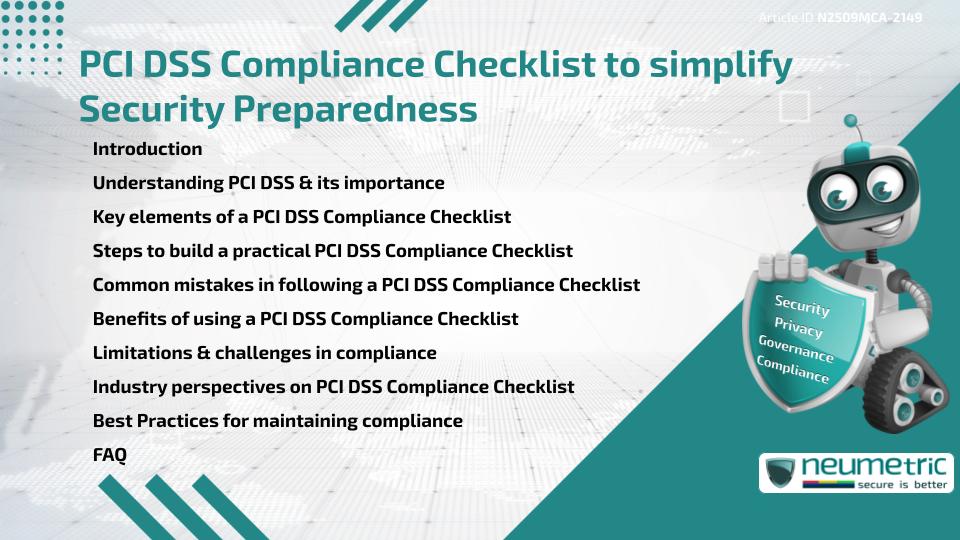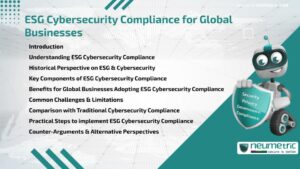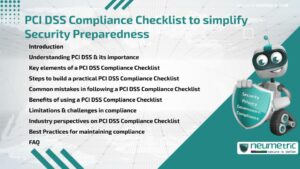Table of Contents
ToggleIntroduction
A PCI DSS Compliance Checklist is a vital tool for Businesses that process, store or transmit Payment Card Data. It helps Organisations simplify security preparedness by breaking down the twelve (12) requirements of the Payment Card Industry Data Security Standard [PCI DSS] into clear, actionable steps. With growing Threats of data breaches & Financial fraud, companies need a practical guide that ensures compliance while safeguarding sensitive cardholder information. This article explores the purpose, elements, benefits & challenges of a PCI DSS Compliance Checklist, offering actionable insights & Best Practices for Organisations of all sizes.
Understanding PCI DSS & its importance
The Payment Card Industry Data Security Standard [PCI DSS] was created by the major card brands to protect cardholder data & reduce fraud. Any company that accepts or handles Payment Cards must comply with PCI DSS requirements. A PCI DSS Compliance Checklist makes this easier by mapping each requirement into manageable tasks, such as securing networks, protecting stored Cardholder Data & monitoring access.
Compliance is not only a legal or contractual obligation but also a way to build trust with customers. Failure to comply can result in heavy penalties, reputational damage & even loss of the ability to process payments.
Key elements of a PCI DSS Compliance Checklist
A good checklist typically covers:
- Building & maintaining Secure Networks
- Protecting Cardholder Data
- Implementing strong Access Control measures
- Monitoring & testing networks
- Maintaining an Information Security Policy
These elements align with the twelve (12) PCI DSS requirements but translate them into actionable measures. For example, instead of saying “use strong cryptography,” a checklist might specify “implement TLS 1.2 or higher for all data transmissions.”
Steps to build a practical PCI DSS Compliance Checklist
To create an effective checklist:
- Review the PCI DSS Standard in detail.
- Identify which requirements apply to your business model.
- Translate each requirement into simple, task-based items.
- Assign responsibilities to specific staff or departments.
- Regularly update the checklist to reflect new PCI DSS versions & security Threats.
A well-structured PCI DSS Compliance Checklist should be dynamic, evolving alongside your technology & business processes.
Common mistakes in following a PCI DSS Compliance Checklist
Organisations often make errors such as:
- Treating the checklist as a one-time activity instead of ongoing work.
- Overlooking staff training & awareness.
- Assuming that outsourced vendors automatically guarantee compliance.
- Failing to maintain documentation for audits.
Avoiding these mistakes ensures that the checklist truly supports compliance rather than becoming a box-ticking exercise.
Benefits of using a PCI DSS Compliance Checklist
The benefits include:
- Clear structure for meeting Compliance Requirements.
- Improved communication across teams handling Payment Data.
- Faster preparation for audits & assessments.
- Reduced Risk of fines & penalties.
- Enhanced Customer Trust & confidence in payment security.
Limitations & challenges in compliance
While a PCI DSS Compliance Checklist is useful, it has its limits. Different Organisations have unique network architectures & business models, so a generic checklist may not cover everything. Compliance can also be resource-intensive, requiring dedicated staff, time & Financial investment. In addition, achieving compliance does not guarantee complete immunity from cyberattacks.
Industry perspectives on PCI DSS Compliance Checklist
Across industries, there is recognition that checklists reduce complexity & increase accountability. Retailers, Financial Institutions & Healthcare Organisations each adapt the PCI DSS Compliance Checklist to fit their workflows. However, some critics argue that over-reliance on checklists can lead to a false sense of security if businesses stop at compliance instead of pursuing broader Information Security goals.
Best Practices for maintaining compliance
- Integrate the checklist into daily operations rather than occasional reviews.
- Train Employees on their roles in maintaining compliance.
- Conduct internal audits regularly.
- Work closely with Third Party vendors to ensure their compliance.
- Use automated tools to track & update checklist progress.
Takeaways
A PCI DSS Compliance Checklist is more than just a compliance aid; it is a practical roadmap for security preparedness. By breaking down complex standards into simple steps, businesses can better protect cardholder data, reduce Risks & demonstrate responsibility to customers.
FAQ
What is a PCI DSS Compliance Checklist?
It is a structured list of tasks that help businesses meet the requirements of the Payment Card Industry Data Security Standard [PCI DSS].
Why is a PCI DSS Compliance Checklist important?
It simplifies compliance, ensures no requirement is overlooked & helps protect Sensitive Payment Card Data.
Does following a checklist guarantee full compliance?
Not necessarily. A checklist supports compliance but must be tailored to specific business processes & systems.
How often should a PCI DSS Compliance Checklist be updated?
It should be updated whenever PCI DSS standards are revised or when there are major changes in Business Operations.
Who should be responsible for the checklist?
Responsibility typically falls to the Information Security team, but all Employees handling Payment Data must be involved.
Can Small Businesses use the same checklist as large corporations?
Yes, but it should be scaled to fit the size & complexity of the business.
What happens if a business ignores the PCI DSS Compliance Checklist?
It risks fines, penalties, reputational damage & potential loss of the ability to process payments.
References
- PCI Security Standards Council Official Site
- National Institute of Standards & Technology – NIST
- Cybersecurity & Infrastructure Security Agency – CISA
- ISACA – Information Systems Audit & Control Association
- SANS Institute Cybersecurity Resources
Need help for Security, Privacy, Governance & VAPT?
Neumetric provides organisations the necessary help to achieve their Cybersecurity, Compliance, Governance, Privacy, Certifications & Pentesting needs.
Organisations & Businesses, specifically those which provide SaaS & AI Solutions in the Fintech, BFSI & other regulated sectors, usually need a Cybersecurity Partner for meeting & maintaining the ongoing Security & Privacy needs & requirements of their Enterprise Clients & Privacy conscious Customers.
SOC 2, ISO 27001, ISO 42001, NIST, HIPAA, HECVAT, EU GDPR are some of the Frameworks that are served by Fusion – a SaaS, multimodular, multitenant, centralised, automated, Cybersecurity & Compliance Management system.
Neumetric also provides Expert Services for technical security which covers VAPT for Web Applications, APIs, iOS & Android Mobile Apps, Security Testing for AWS & other Cloud Environments & Cloud Infrastructure & other similar scopes.
Reach out to us by Email or filling out the Contact Form…





